
RER D is one of the five lines in the Réseau Express Régional, a hybrid commuter rail and rapid transit system serving Paris and its suburbs. The 190-kilometre (120 mi) line crosses the region from north to south, with all trains serving a group of stations in central Paris, before branching out towards the ends of the line.

Lyon-Perrache is a large railway station located in the Perrache district, in the 2nd arrondissement of Lyon, France. The station was opened in 1857 and is located on the Paris–Marseille railway, Lyon–Geneva railway and Moret–Lyon railway. The train services are operated by SNCF and include TGV, Intercity and local services.
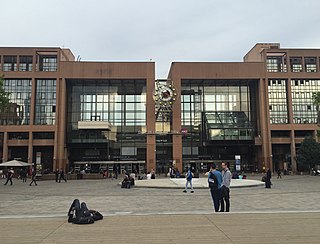
Gare de la Part-Dieu is the primary railway station of Lyon's Central Business District in France. It belongs to the Paris-Lyon-Marseille railway. Train services are mainly operated by SNCF with frequent TGV high-speed and TER regional services as well as Eurostar and Deutsche Bahn. Lyon's second railway station, Lyon-Perrache station, is located in the south of the historical centre.

Moret–Veneux-les-Sablons is a railway station in Veneux-les-Sablons and Moret-sur-Loing, Île-de-France, France. It is on the Paris–Marseille railway, and at the beginning of a branch line to Nevers and Clermont-Ferrand.
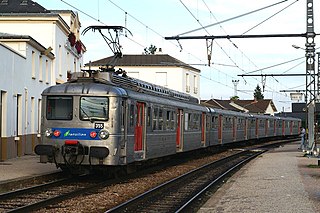
SNCF Class Z 5300 are three and four car Electric Multiple Unit type for Paris commuter and regional services. They were built by Carel et Fouche, MTE/Francorail, Fives-Lille and OC Oerlikon between 1965 and 1968 and 1972 and 1975. Many of these trains have been withdrawn starting from 2003.

Frecciarossa is a high-speed train of the Italian national train operator, Trenitalia, as well as a member of the train category Le Frecce. The name was introduced in 2008 after it had previously been known as Eurostar Italia. Frecciarossa trains operate at speeds of up to 300 km/h (190 mph). Frecciarossa is the premier service of Trenitalia and competes with italo, operated by Nuovo Trasporto Viaggiatori. Trenitalia also operates the sister brands Frecciargento and Frecciabianca for slower services.
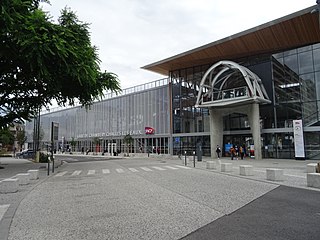
Chambéry-Challes-les-Eaux station is a railway station in the Savoie département of France. The station serves the city of Chambéry. The station is served by three major high speed services, the TGV, Eurostar and Frecciarossa.

Juvisy is a railway station in Juvisy-sur-Orge, Essonne, Île-de-France, France. The station was opened in 1840 and is on the Paris–Bordeaux railway, Villeneuve-Saint-Georges-Montargis railway and Grande Ceinture line, a freight railway around Paris. The station is served by Paris' express suburban rail system, the RER Line C and RER Line D. The train services are operated by SNCF. A TGV high-speed service also serves the station. During a survey in 2015, the station served 33,426,629 passengers in that year.

Melun station is a railway station in Melun, Seine-et-Marne, Paris, France. The station was opened on 3 January 1849 and is on the Paris–Marseille railway. The station is served by Paris' express suburban rail system, the RER. The train services are operated by SNCF.

The railway from Paris to Marseille is an 862-kilometre long railway line, that connects Paris to the southern port city of Marseille, France, via Dijon and Lyon. The railway was opened in several stages between 1847 and 1856, when the final section through Lyon was opened. The opening of the LGV Sud-Est high speed line from Paris to Lyon in 1981, the LGV Rhône-Alpes in 1992 and the LGV Méditerranée in 2001 has decreased its importance for passenger traffic.
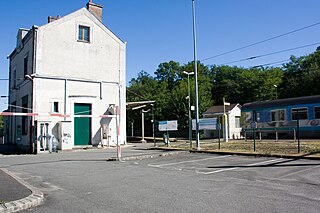
Thomery station is a railway station in Thomery, Île-de-France, France.
Trenitalia France is an open-access train operator running international services between France and Italy. It was originally established under the Thello brand in October 2011.

Bardonecchia railway station serves the town and comune of Bardonecchia, in the Piedmont region of northwestern Italy. The station is a through station of the Turin-Modane railway. The train services are operated by Trenitalia and SNCF.
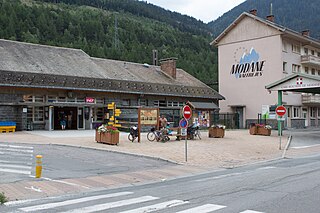
Modane is a railway station located in Modane, Savoie, France. The station was opened on 17 September 1871 and is located on the Culoz–Modane railway. The train services are operated by SNCF.
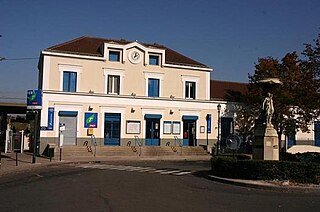
Montgeron-Crosne is a railway station in Montgeron, Essonne, Île-de-France, France. The station was opened in 1995 and is on the Paris–Marseille railway. The station is served by the RER Line D, which is operated by SNCF. The station serves the communes of Montgeron and Crosne.
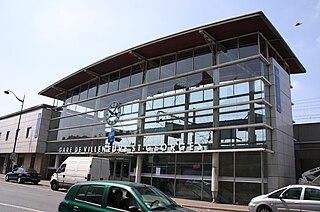
Villeneuve-Saint-Georges is a station in Villeneuve-Saint-Georges, Val-de-Marne, Île-de-France, France. The station was opened on 12 August 1849, and it is on the Paris-Marseille railway and the Villeneuve-Saint-Georges–Montargis railway. This station, together with the station of Villeneuve-Triage, serves the commune of Villeneuve-Saint-Georges.

Combs-la-Ville–Quincy is a RER station in Combs-la-Ville, Seine-et-Marne, Île-de-France, France. The station was opened on 12 August 1849 and is on the Paris–Marseille railway. The RER Line D, which is operated by the SNCF, serves the station.
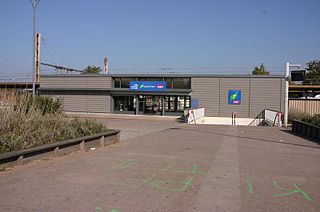
Boussy-Saint-Antoine is a railway station on the border of Boussy-Saint-Antoine and Quincy-sous-Senart, both in Essonne, Île-de-France, France. The station was opened in 1995 and is on the Paris–Marseille railway. The station is served by the RER Line D, which is operated by SNCF. The station serves the communes of Boussy-Saint-Antoine, Épinay-sous-Sénart and Quincy-sous-Senart.

Villiers-le-Bel – Gonesse – Arnouville is a railway station in Arnouville, Essonne, Île-de-France, France. The station was opened in 1859 and is on the Paris–Lille railway. The station is served by the RER Line D, which is operated by SNCF. The station serves the communes of Arnouville, to the north Villiers-le-Bel and, to the east, Gonesse.

The Milan–Paris Frecciarossa is a high-speed passenger railway service running between Milano Centrale and Paris Gare de Lyon, marketed under Trenitalia's Frecciarossa brand.
























